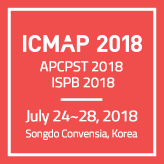| KEYNOTE Chemical and Biological Mechanisms of Plasma Interaction with Biosystems |
 Alexander Fridman Alexander Fridman |
Drexel University, USA |
| KEYNOTE Novel cancer treatments based on syntheticapproaches of plasma-activated liquids |
Masaru Hori |
Nagoya University, Japan |
| KEYNOTE From single plasma jets to large atmospheric plasma sources for biological applications |
 Jean-Michel Pouvesle Jean-Michel Pouvesle |
GREMI, CNRS/University of Orleans, France |
| KEYNOTE Research and development of plasma sources for applications in life science. |
 Klaus Dieter Weltmann Klaus Dieter Weltmann |
INP Greifswald, Germany |
| Combined effect of cold plasma and nanoemulsion-based drug delivery system for targeting human melanoma |
Manish Adhikari |
PBRC, Korea |
| Role of protein folding in plasma medicine |
 Pankaj Attri Pankaj Attri |
University of Antwerp, Belgium |
| Development and application of skin equivalents forthe investigation of atmospheric pressure plasma |
Ku Youn Baik |
Kwangwoon University, Korea |
| Cold Atmospheric Pressure Plasma Treatment to Assist Bacterial Inactivation and Tooth Restoration in Endodontic Procedures |
 Vittorio Colombo Vittorio Colombo |
University of Bologna, Italy |
| Cold plasma assisted wound healing: from bactericidal effects to tissue regeneration |
 Svetlana Ermolaeva Svetlana Ermolaeva |
Gamaleya Research Center of Epidemiology and Microbiology, Russia |
| Mechanisms and Control of Plasma Biomedical Processes |
 David Graves David Graves |
University of California, USA |
| Cold atmospheric plasma for the treatment of intraoral (precancerous) lesions - in vitro and in vivo investigations |
 Sybille Hasse Sybille Hasse |
INP Greifswald, Germany |
| Current Status and Future Challenges in Modeling and Numerical Simulation for Plasma Medicine |
Satoshi Hamaguchi |
Osaka University, Japan |
| The effect of melanogenic differentiation by non-thermal atmospheric biocompatible plasma |
Ihn Han |
Kwangwoon University, Korea |
| Comparison of ROS Diagnostic Methods for Atmospheric-pressure Plasmas at Gas-Liquid Environment |
 Seiji Kanazawa Seiji Kanazawa |
Oita University, Japan |
| Plasma induced immuno-modulations for medical applications |
 Nagendra Kaushik Nagendra Kaushik |
Kwangwoon University, Korea |
| Application of cold atmospheric plasma to overcome drug-resistance in cancer cells |
 Sun Jung Kim Sun Jung Kim |
Dongguk University, Korea |
| Plasma Bioscience in Dentistry |
 Jae Sung Kwon Jae Sung Kwon |
Yonsei University, Korea |
| Plasma and ROS Effects on G-Protein Coupled Receptor Signaling |
Weontae Lee |
Yonsei University, Korea |
| Influence of reactive oxygen and nitrogen species on the plasmid DNA and transformation of Escherichia coli with plasmid |
 Geon Joon Lee Geon Joon Lee |
Kwangwoon University, Korea |
| The transdermal and wound healing effect of plasma activated medium |
Dawei Liu |
Huazhong University of Science and Technology, China |
| The effect of tissue and medium on the penetration of RONS generated by plasma |
 XinPei Lu XinPei Lu |
HuaZhong University of Science and Technology, China |
| Cold Atmospheric Pressure Plasma Mediated Wound Healing |
 Kai Masur Kai Masur |
INP Greifswald, Germany |
| Long term investigation of radical activated water |
 Jun-Seok Oh Jun-Seok Oh |
Osaka City University, Japan |
| Novel surface assisted laser desorption / ionization mass spectrometry using carbon nanowalls for analyzing bio molecule |
Takayuki Ohta |
Meijo University, Japn |
Propertiesof Dawoo Korea Plasma Sterilizer Using Nonthermal Atmospheric Pressure |
Jang Sick Park |
Korea Industrial Technology Association, Korea |
| Cold plasma promotes angiogenesis in acute rodent wounds |
Anke Schmidt |
INP Greifswald, Germany |
| The effect of cold atmospheric pressure plasma (CAP) on cell migratory behaviors and molecular markers of wound healing machinery |
 Debarati Shome Debarati Shome |
INP Greifswald, Germany |
| Nitrogen Monoxide Generation by Microwave Plasma Torch. |
 Hansup Uhm Hansup Uhm |
Kwangwoon University, Korea |
| Plasma in cosmetic applications: possibilities and boundary conditions |
Thomas von Woedtke |
INP Greifswald, Germany |
| Insight into the Molecular Dynamic Simulation Studies of Reactive Oxygen Species in Native and Oxidized skin membrane |
 Dharmendra Kumar Yadav Dharmendra Kumar Yadav |
Gachon University of Medicine and Science, Korea |
 Tomohiro Nozaki
Tomohiro Nozaki
